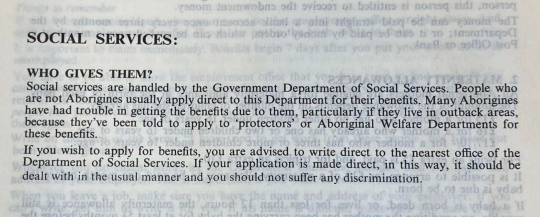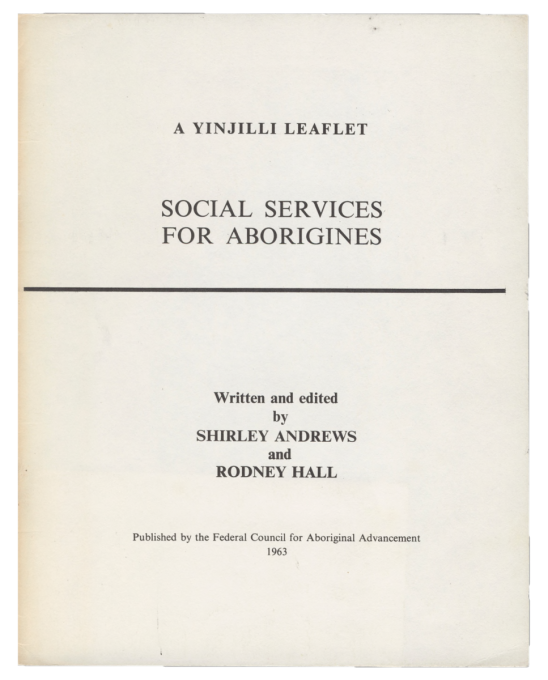
Advocates publish Yinjilli leaflet to help people understand entitlements
With many Aboriginal and Torres Strait Islander people missing out on payments, the Federal Council of Aboriginal Advancement wrote a leaflet to provide guidance about accessing payments.
Many Aborigines have had trouble in getting the benefits due to them, particularly if they live in outback areas ...
| Attachment | Size |
|---|---|
| a-yinjilli-leaflet.pdf | 2.96 MB |
| Attachment | Size |
|---|---|
| a-yinjilli-leaflet.docx | 82.27 KB |
Although many Aboriginal people became eligible for government payments in 1959, it was still difficult for people to get their entitlements. Government processes were often discriminatory and information for Aboriginal audiences was lacking.
To help people claim payments, the Federal Council of Aboriginal Advancement (FCAA) wrote to the government about these issues.
Following the government’s response, the FCAA created their own leaflet for Aboriginal people explaining the 8 payments they were entitled to.
Difficulties Aboriginal people faced getting payments
Shirley Andrews wrote to the Department of Social Services (DSS) after the FCAA’s December 1962 Cairns Conference. Andrews reported that conference participants were frustrated by the ‘unjust and patronising’ practices around applying for payments and how officials decided if someone was eligible. She said that ‘every difficulty and obstruction’ was put in the way of Aboriginal applicants. She also pointed out that many Aboriginal people didn’t even know what payments they were eligible for because the government didn’t try to communicate with them.
Andrews also discussed the issue of ‘protectors’ who worked in state governments and often decided whether Aboriginal people got a payment. She included a story of a non-Aboriginal journalist and his wife who witnessed a protector denying Aboriginal people payments because ‘he didn’t feel in the mood to pay out the social service money that day’.
Information to help: the Yinjilli leaflet
To address some of the FCAA’s issues, Andrews said she was drafting a leaflet for Aboriginal people that would help them access payments. Andrews asked 11 questions of the Director of the Department of Social Services (DSS) to collect information for the leaflet.
Andrews used information from DSS’s response to co-author the Yinjilli leaflet with Rodney Hall. The leaflet explained to Aboriginal and Torres Strait Islander people which payments they were entitled to and how to apply.
Advice to apply directly to DSS
Andrews and Hall knew about the discrimination Aboriginal applicants faced. They noted that people often had ‘trouble getting the benefits due to them ... because they've been told to apply to “protectors” or Aboriginal Welfare Departments’. The ‘protectors’ they referred to were state government welfare officers who previously had control over who got payments. For example, the Western Australian Government published a booklet about citizenship and payments and told readers to apply for payments through their welfare officer.
The Yinjilli leaflet advised people to apply directly to DSS to ensure they got their full payment.

Advice about how to prove eligibility
Another issue the authors gave advice about was proof of age requirements. For a long time, the government didn’t give Aboriginal people birth certificates. This made it very hard to prove age and access payments such as Old-age Pension.
Under the part about Old-age Pension they wrote:
If you know somebody who is not an Aborigine, who can help to prove your age, take this person (or a written statement from him) to the Social Services Department. This does not mean that the Department will only believe people who are not Aborigines. It is because they have proof of the age of these other people.
Leaflet distribution
Historian Sue Taffe (2001:188-189) found that the FCAA distributed 5,000 copies of the Yinjilli leaflet. They sent them throughout Victoria, South Australia, Western Australia and the Northern Territory.
Despite the FCAA’s good intentions, the text-based leaflet may not have been effective because of the literacy levels of the audience. However, this leaflet is an important example of the FCAA’s efforts to communicate to Aboriginal people about their entitlements.
As well as communicating to Aboriginal people, the FCAA also advocated to government for change. For example, they fought for equal wages for Aboriginal people and access to more payments, such as Tuberculosis Allowance.
Better information from government
Memos between departments from 1964, the year after Andrews published the leaflet, show that the government wasn’t supportive of it.
DSS said they were worried people would think it was an official DSS document. They also said that information published for a general audience, like the Commonwealth social services handbook, was good enough.
It would take many years for the government to improve how they communicated with Aboriginal and Torres Strait Islander people about payments, for example, by translating information into language.
Shirley Andrews served as Campaign Officer for the FCAA (later FCAATSI) and Secretary for the Council of Aboriginal Rights. The Yinjilli leaflet was written by Andrews and Rodney Hall and published by the FCAA.
The version of the Yinjilli leaflet included here is held in the collections of AIATSIS.
You can also access another version of the Yinjilli leaflet on the website Collaborating for Indigenous rights 1957–1973 (2014) by the National Museum of Australia. This version originally came from the Council for Aboriginal Rights collection held by the State Library of Victoria.
The letters from Shirley Andrews and related correspondence were kept in a file by the Department of Social Services. The file was later transferred to the National Archives of Australia, which holds it as part of the national archival collection.
You can view these letters through RecordSearch online. For Andrews’s letters, go to pages 119–122 and 114–115. For the DSS view of the Yinjilli leaflet, go to pages 80–81 and 74–76.
Permissions
Permission to include the leaflet here was granted by Rodney Hall.
Citation
Andrews S and Hall R (1963) A Yinjilli leaflet: social services for Aborigines, Federal Council for Aboriginal Advancement.
National Archives of Australia: Department of Social Services; A884, Correspondence files, 1951–1974; A2870, Requests for departmental information on Aborigines, 1963–1973.
